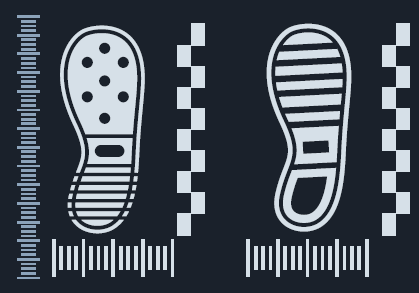Ways of Working115
Forensic Flow
The Manifesto for Agile Software Development and Crime Scene Exhibit Processing
Katie Bianchi
December 5, 2020
The Manifesto for Agile Software Development and Crime Scene Exhibit Processing
Katie Bianchi
December 5, 2020
 The forensic examination of crime scenes is a vital part of modern policing. There are many components to a successful crime scene investigation: preservation, documentation, and the collection and analysis of evidence. Items removed from the scene are referred to as exhibits, and are chemically examined in the controlled environment of a police force laboratory.
The forensic examination of crime scenes is a vital part of modern policing. There are many components to a successful crime scene investigation: preservation, documentation, and the collection and analysis of evidence. Items removed from the scene are referred to as exhibits, and are chemically examined in the controlled environment of a police force laboratory.
Once at the laboratory, officers can decide on the exact treatments required for each exhibit, as well as the sequential processing appropriate for the discovery and analysis of Fingermarks (as per the Fingermark Visualisation Manual).
Laboratories are equipped to handle a large and constant flow of exhibits from multiple crime scenes, with the expectation that many, if not most of those exhibits, may bear no material evidence. All of this is in pursuit of crucial forensic evidence – trace evidence, or an isolated fingermark.
It may seem inconceivable that the manifesto for agile software development and forensic policing have commonality. However, there are many points of similarity between the two. The values from the manifesto are not only directly transferable, but can be leveraged to assist in the processing and documentation of forensic evidence, and in turn help the wider community.
Commonalities between Crime Scene Exhibit Processing and The Agile Manifesto are as follows:
Individuals and Interactions over Processes and Tools
While forensic investigations use many processes and tools, the heart of an investigation is guided by the collaboration between numerous skilled professionals. It is these interactions that are vital to the success of any investigation, rather than any single piece of equipment on hand.
Working Software over Comprehension Documentation
Just as imperfect but functional software can be iterated and improved upon, so can forensic evidence. An example of this is in the recovery of fingermarks: due to the nature of chemical treatments and sequential processing, there is the ability to incrementally deliver marks (a working software equivalent) to the fingerprint bureau. These marks can be submitted to the bureau and enable an immediate advance in the investigation, rather than wait for a complete examination to be done and a potentially larger batch (more marks) to be submitted.
Customer Collaboration over Contract Negotiation
While police officers and detectives may not have customers, they do work with forensic teams in a manner that could be viewed through the lens of a client/contractor relationship. Their “contracts” are laws and policies, like Standard Operating Procedures (SOPs).
While it is essential that SOPs be followed, it is just as important for forensic teams to remember that Police Officers and detectives are representing victims of crime. It is vital that these ‘customer’ (victims of crime) are put first. This is achieved by considering fulfilling the needs of victim via successful collaboration between forensics and officers as more important than inter-departmental agreements on how a force works together.Fulfilling the needs of victims via successful collaboration between forensics and officers is more important than inter-departmental agreements on how they work together.
Responding to Change over Following a Plan
Every investigation begins with a plan, based upon investigation information and the aforementioned SOPs. Unfortunately, every crime scene is unique, and situations can rapidly change and evolve. When this happens it is crucial that an officer can demonstrate flexibility by altering their original plan as and when needed, without violating the SOPs.
These connections between the values from the agile manifesto and forensic examination are interesting, but only theoretical. What follows are examples of how a police force used principles from Kanban and Lean to help improve the efficiency of their forensics laboratory. These changes consequently helped the force provide a better service to their community.
Kanban has six core practices which involve seeing the work and using this information to improve the processes. Below are how four of these practices were implemented and the resulting benefits.
1. Visualization of Workflow
The management and examination of forensic exhibits is performed according to a general sequence of steps which maximizes outcomes (which in this environment is forensic evidence). Kanban suggests that practitioners visualize their work and how it flows through a system, in order to improve efficiency.
In our example forensic laboratory, this was put into practice. Rather than keep all exhibits within the storage room while awaiting chemical treatment, the storage was ordered to mimic a flow. Storage racks became columns, each related to a treatment type. Further refinement was achieved by creating swim lanes inside each rack. More urgent work was moved onto the top swim lane, which allowed an officer to glance into the storage area and immediately see how much work there was and where the bulk of that work was sitting.

Defining work item types: Kanban highlights that systems often have different types of work and suggest that these be grouped into what are called work item types. The forensic lab in question had already categorized the crimes used on how they are defined in law, and these categories were used to form three work items: Major, Volume and Other.
Kanban cards are a simple practice that summarize important work information into simple, clear cards or notes for clarity. These practices were implemented by creating a folder for each crime. These folders contained information such as the work item’s age. Additionally, to assist with the visualization of differences between work item types (or crime types), folders were colour-coded red, blue or brown.
When combined with changes to workflow, this created a system where red (major) item types could be readily identified and moved into the swim lanes, assisting in the visualization of work flow
Commitment points and delivery points: A core principle of the Kanban method is that work should be processed in small, fast batches in order to optimize flow. This is achieved by examining the workflow and deciding upon a commitment point (the moment the worker will commit to undertaking the work and measuring progress) and a delivery point (the moment a task is considered delivered, and measurement stops).
The forensic laboratory applied these principles by setting the commitment point of the workflow as the moment an exhibit was submitted to the lab. The delivery point was slightly different as it consisted of the completion of one treatment, examination and mark up of all fingermarks from that treatment, the photography of all that treatments marks and their sequential submission to the fingerprint bureau.

2. Make Policies Explicit
The goal of Kanban policies is to remove confusion, to allow team members to operate without second guessing themselves, and to increase team effectiveness.
The forensics team modelled this by examining their policies on chemical treatments for exhibits. There are several chemical treatments that can be applied to exhibits, but the additional benefits of using them all are small. Given this cost and benefit it was possible to create policies that put limits on the number of chemical treatments undertaken based on the work items types (specifically, Volume and Other types), thus creating a more efficient workflow.
3. Manage the Flow
Work items ageing: With the forensic team’s commitment and delivery points defined, they were now able to implement Service Level Expectations (SLE’s). SLE’s are the time taken for a work item to go from the commitment to delivery point. With three work item type, it meant that there were three corresponding SLE’s for Major, Volume and Other crime of 3, 5 and 10 working days.
A core principal of Kanban is that you cannot manage what you do not measure. One standard measurement within Kanban is the time an item has been in-progress since it reached the commitment point. It was not practical to mark the number of days work items had been in a system, so an alternative was devised where each folder was labelled with the date the work item (encompassing all exhibits within it) was submitted to the lab. Officers used this information to make informed decisions on how many, and which work items they would include in their next batch of treatment/examination/photography. This ensured the flow of all work types and aided in SLE’s being met.
Bottlenecks and cross working: Kanban aims to highlight bottlenecks. It achieves this through limiting work in progress. Officers didn’t have the luxury of limiting the amount of crimes committed, but they were capable of the decision making, treatment, examination and photography of exhibits. Rather than having one officer follow a work item through all stages, the ways of working were modified (with exceptions). A rota for treatment types was created with officers spending a few weeks primarily at one work station. This meant that if there was no flow into one column (for example, photography), the officer at that station could look at the upstream treatments and identify where there was a bottleneck. They could then alter their work to provide support elsewhere and assist in restoring flow.
4. Feedback Loops
Kaizen – seeking a process of continual improvement – is a vital element in Kanban, and fingermark development is no different. The laboratory and fingerprint bureau collaborated to ensure an appropriate percentage of marks photographed were of identifiable quality. New officers were also paired with a fingerprint expert for short feedback loops on their quality, in order to continually improve the standards of fingermark detection and analysis.
Lean wastes: Lean asks users to examine steps in large systems and identify which add value and which are non-value. Non-value add steps can be difficult to spot, but Lean provides guidance in the highlighting of seven wastes, which are often non-value add steps.
Forensic examinations also have a flow of value, with the ultimate goal being the enhancement and capture of fingermarks. The team in question mapped their processes according to Lean principles, and identified three wastes which they were able to remove from their flow, making them more efficient in the delivery of value.
Over-Processing: Over-processing waste refers to doing excess work which adds no additional value to a process. With the implementation of the policies around the number of treatments an exhibit undertook, the unit looked at over-processing and the cost/benefit of treatment numbers. This ensured the laboratory’s effort and cost were managed at a sustainable level with the best opportunity for Service Level Expectations to be met, while still meeting acceptable timescales.
Transportation: Transportation waste is the movement of people or things from one location to another. A laboratory redesign allowed the force to reflect upon the transportation costs of having to move back and forth between examination rooms and labs/offices in order to update the exhibit management system on their computers. The simple addition of computers within each examination room removed a huge non-value step and made the process significantly more efficient.

Hand-offs: Handoffs are not only the time required to pass work from one person to another, but also the additional time needed for another person to understand what has already been accomplished, and what their responsibilities are.
A waste was identified in the laboratories photographic system, where film photographs had to be handed to a separate team for printing, returned for QA, and then transported to the fingerprint bureau. By shifting from film to digital photography, and by implementing digital transmission direct from the lab to the fingerprint bureau, numerous non-value add steps were removed and the entire process streamlined.
Agility is an ethos which Lean and Kanban principles enable. These can be beneficial in any context to aid in efficiency and removal of waste. In this example, these practices have been embedded into the processing of crime scene exhibits, with the end result of a faster, more efficient forensics team.
This force is not sitting still either. Continuous improvement has been embedded into their ethos, and they continue to inspect, reflect, and adapt their processes to ensure that the public have the best possible team in place. In this instance, Agile values and principles have contributed to creating a safer, more secure community.
 Katie Bianchi is an experienced and qualified Scrum Master, SAFe Practitioner, Trainer, and Team Leader who is accustomed to working in highly pressured environments in the public eye. Leads highly technical teams including developers, engineers, architects and testers being the link between them and the business.
Katie Bianchi is an experienced and qualified Scrum Master, SAFe Practitioner, Trainer, and Team Leader who is accustomed to working in highly pressured environments in the public eye. Leads highly technical teams including developers, engineers, architects and testers being the link between them and the business.
Please subscribe and become a member to access the entire Business Agility Library without restriction.